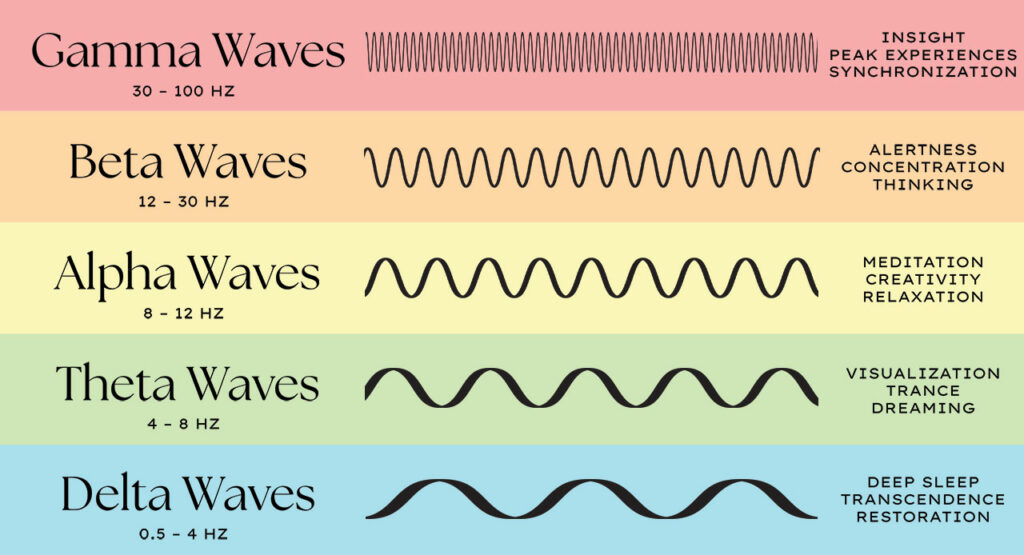If you’re struggling with ADHD or difficulty focusing then you might find my laser focus training protocol helpful which uses gamma and beta brainwave entrainment.
If you have ADHD you can likely hyperfocus on the things that really interest you.
However, the big problem many people with ADHD have is a tendency to hyperfocus on the wrong things (which make us feel good) and avoid doing the more important things (which give us anxiety).
This laser focus process I am going to cover can help to solve these common problems that are associated with the squirrel-like ADHD brain:
1. Inattentiveness: lack of focus or desire to do the work you need to do.
2. Impulsivity: a tendency toward distractibility and seeking instant gratification.
3. Hyperactivity: feeling restless and having difficulty sitting still for long periods.
4. Prioritization: lack of planning and prioritization of the most important work.
5. Procrastination: difficulty sticking to the plan and strong avoidance tendencies.
All of these problems are generally much worse on your off days when you’re tired or stressed so a healthy lifestyle and active recovery habits are also going to be very important for developing the ability to consistently laser-focus at work.
What Is Laser Focus?
Laser-like focus (sometimes also referred to as hyperfocus) is the mental ability to give 100% of your attention to achieve complete absorption in a task, to the point where you are able to completely ignore or “tune out” everything else.
Developing laser-lake focus is important for sustaining your focus on a challenging activity long enough to get into a flow state, which is an optimal state where we feel and perform our best.
ADHD Focusing Tips And Best Practices:
Here are some quick tips and best practices for developing laser-like focus:
- Start with short deep work sessions and go easy on yourself, the human brain is actually designed to be easily distracted and not to laser focus on a single task for long periods of time.
- To sustain laser-like focus you need to take regular breaks where you get up and do mindful activities like going for a short walk, taking a washroom break, briefly meditating, listening to music, brewing a cup of tea or drinking a glass of water.
- Avoid mindless activities on your breaks such as checking your smartphone or visiting a distracting website in your web browser for a quick dopamine hit. I recommend putting your smartphone in another room for your entire session.
- Most people can only laser focus for 2-3 hours a day on cognitively demanding tasks so schedule your daily laser focus session for the morning or when you generally have your best energy of the day.
Building A Laser Focus Habit That Sticks:
Let’s face it, focusing is getting really hard in this hyperconnected digital world we live in, especially on those off days when you’re feeling tired or unmotivated so it’s important to start small with a realistic goal.
Here’s my step-by-step laser focus training protocol if you want to train your mind for laser-like focus.
1. Follow a proven habit formation sequence.
The fastest way to build a new habit that sticks and break bad habits that derail your focus and attention is by following this 3-step process that is backed by the latest scientific research into habit formation:
1. Trigger: Schedule the same time everyday for a laser focus session.
2. Routine: Consistently follow a routine similar to the one I outline below.
3. Reward: Reward yourself afterwards with something you enjoy
I recommend pre-planning with your week and scheduling laser focus sessions for each weekday in your calendar if you want to build a consistent habit that sticks.
2. Set a goal that you can easily measure for your session.
I recommend quickly writing out a S.M.A.R.T. (Specific, Measurable, Attainable, Realistic, Timely) goal like this:
I will focus on [my most important project/tasks] for the [next 2 hours] and I will use a Pomodoro Timer to complete 4 sessions of 25 minutes of uninterrupted focus followed by brief 5-minute mindful breaks.
3. Create the ideal digital environment for focus by eliminating distractions.
I recommend having a separate web browser only for these focused flow sessions to create strong mental associations for focus and being productive.
It helps to use a timer, a website-blocking tool to remove all potential distractions and put your smartphone on DND (or ideally in another room).
I cover my top 10 productivity tools for creating an optimal digital environment for focus and flow in my free Flow Productivity Toolkit.
4. Visualize the outcome and the step-by-step process you will follow to achieve your goal.
Spend 30-60 seconds visualizing your goal outcome, and the obstacles (internal or external triggers) that may come up and mentally rehearse what you will do when they arise to let them go and mindfully stick to your goal.
5. Choose a brainwave entrainment frequency in the gamma or beta frequency range.
While there are different kinds of ADHD and neurodivergent brains, the general brainwave signature of ADHD tends to be higher theta wave activity (associated with daydreaming, mind wandering and lack of urgency) and lower beta wave activity (associated with focus, executive functioning and strong task orientation).
It can take 5-15 minutes for your brain waves to entrain to brainwave entrainment music like binaural beats and isochronic tones so listen to a track for at least 25 minutes.
With brainwave entrainment music, it’s important to experiment to see what works for you as everyone’s brain and how they respond to different brainwave frequencies is slightly different.
This is what I have found to be the best brainwave entrainment frequencies for laser-like focus (with links to binaural beats and isochronic tones tracks on YouTube):
Gamma waves from 30 – 40 Hz for shifting into high-intensity and energized hyperfocus.
High-beta waves (20 – 30 Hz) for jolting yourself awake when you’re tired or sluggish.
Mid-beta waves (15 – 20 Hz) for linear problem-solving and a task-oriented focus.
Low-beta waves (12 – 15 Hz) for relaxed focus and sustained concentration.
It’s important to experiment and see what brainwave signatures work best for you.
Flow State Music:

While beta and gamma waves are excellent for laser-like focus, the flow state happens when we are highly engaged in an activity and able to relax effortlessly into the process of what we are doing.
The brain waves of flow involve relaxed alpha waves and as you go deeper into the flow state you can experience the selflessness, timelessness and effortlessness that is characteristic of brain waves along the alpha and theta borderline (often referred to as transient hypofrontality).
I’ve found that the best shortcut into the flow state is using brainwave entrainment music such as binaural beats and isochronic tones.
I have been using brainwave entrainment music for over 20 years to help with my ADHD and over that time I have created a large collection of brainwave entrainment music that is available in my Flow State Training course.
This premium music collection includes over 100 binaural beats music tracks for the entrainment of different brainwave states. I have also included guides for using music to get into dreamlike liminal states and for falling asleep faster at night.
The advantage of premium brainwave entrainment music is the audio files aren’t compressed like they are on YouTube and that makes them more effective for systematic training of your brain waves.
That being said, the binaural beats and isochronic tones you will find on YouTube are great for getting your feet wet and experimenting to see what brainwave entrainment can actually do for you.
In future posts, I will be covering more advanced forms of brainwave training using neurofeedback training and wearable “mind machines” that entrain brainwaves using a combination of light and sound.
I recommend starting with brainwave entrainment music because it’s inexpensive and it’s one of the easiest ways to focus and get in flow states when you are working.
- 10 Tips, Tricks And Tools To Overcome ADHD Paralysis - March 19, 2025
- 10 Interesting Facts About Adult ADHD And Mental Health - March 18, 2025
- 15 Ways To Manage ADHD Without Meds By Biohacking Dopamine - February 14, 2025




